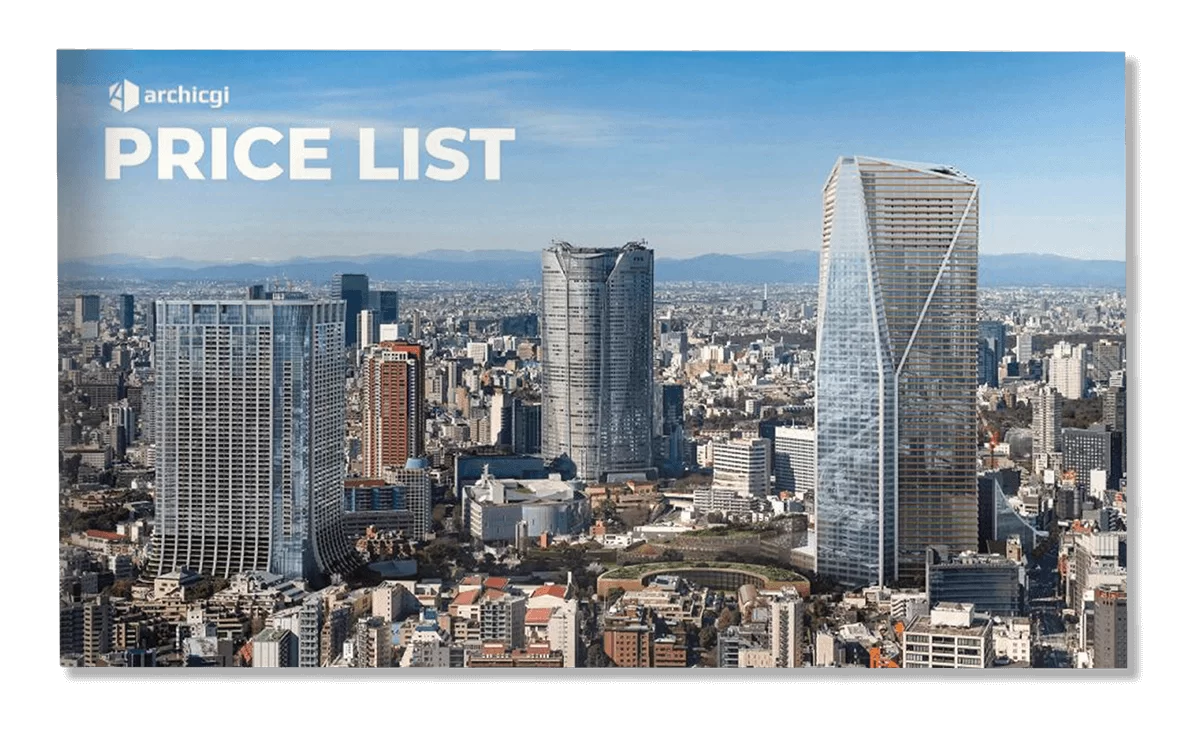Rebecca West is an extraordinary business coach for interior designers. She’s an award-winning design entrepreneur herself, with over 15 years of experience transforming living spaces. At the same time, she’s dedicated to helping others achieve success and gratification in their work with her own coaching and consulting company Seriously Happy.
Rebecca’s career started in 2007 when she founded her design firm without prior business knowledge or a formal design education. However, her innate creative talent and commitment to helping regular people create happier homes and lives through design propelled her forward.
Throughout her journey, Rebecca has remained dedicated to her values and clients, becoming a trailblazer in the industry and inspiring others to embrace their own unique paths. That’s why our architectural visualization studio seized the chance to speak with her about the incredible work she has been doing.
In this interview, Rebecca West shares her experience and invaluable insights. Whether you’re an aspiring interior designer or an established professional looking for a fresh take on the philosophy of running a business, this interview promises to be transformative and inspiring for you. So, let’s dive in!
You’ve run Seriously Happy Homes, an interior design company, for 15+ years. Unlike most designers, you’ve always focused on making regular people’s homes happier instead of catering to the ultra-rich. Can you tell us more about that?
Of course! I’ve had a talent for color and design since I was a little girl. But I’d always thought of interior design as a career that was all about choosing overpriced throw pillows for rich people. That didn’t sound very meaningful to me.
I wanted to help other people use their surroundings to improve their lives.
Then, in 2007, I found myself divorced and living in a house filled with memories of a failed marriage — the colors we’d chosen together, the sofa from his parents, and so on. One day I realized I couldn’t keep living like that, feeling trapped by my past. I sold everything, repainted all my walls in soft, feminine colors, and bought all “new to me” furniture. I went from feeling trapped by my past to looking at a bright future, full of possibility.
That’s when I realized interior design has a lot of power! I wanted to help other people use their surroundings to improve their lives, too. So I started Seriously Happy Homes determined to help “real people” get happy at home just like I had!
I have to admit that I got a lot of well-meant advice over the years to change my target market and focus on the ultra-wealthy. But I knew that if I did that the passion I felt for my work would evaporate, and I would be just another designer serving the mega-rich. So I stayed true to my path, ultimately writing my book, Happy Starts at Home, all about design psychology and how we can use our homes to improve our lives.
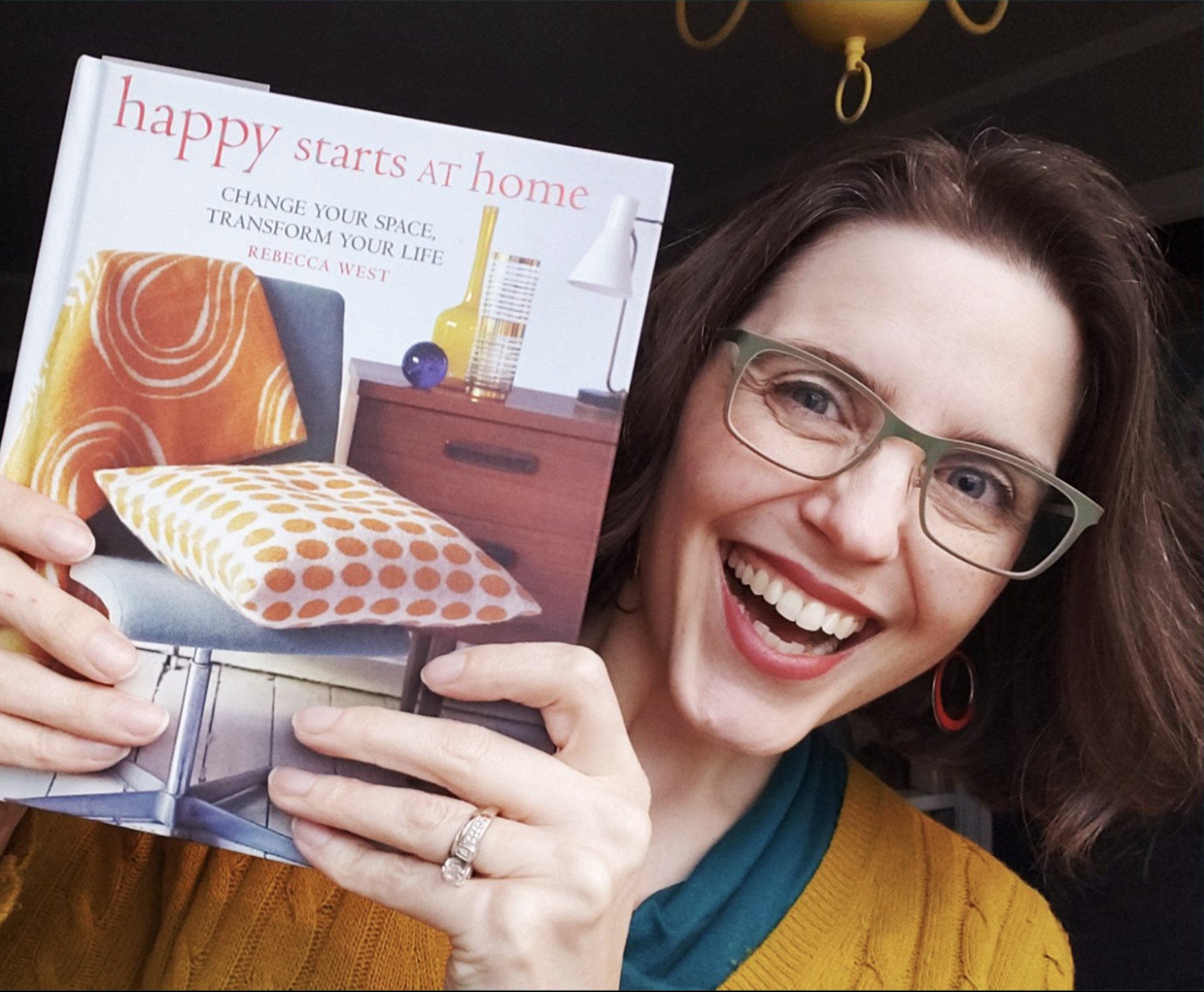
So, you already had a successful career as an interior designer. What inspired you to become a coach and consultant for design businesses?
It really started when I began hearing compliments from my contractors like “No one includes the level of detail in their design files like you do” and “There’s no one like you.” We’d hear it directly from contractors, and also from our clients in their reviews.
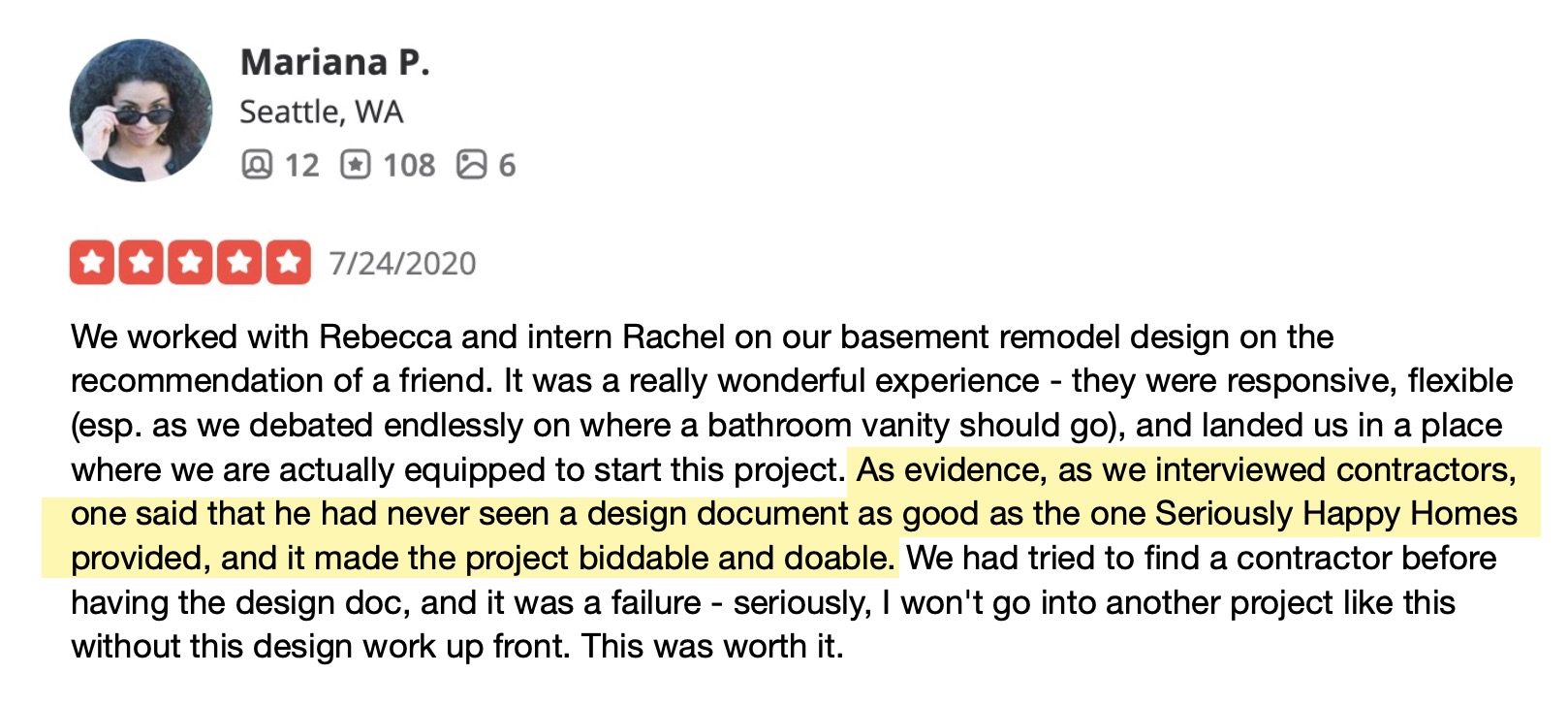
Those were lovely compliments but I was like “Whaaaaaat? How can other designers not be doing this the way I am?!”
Success as an interior designer doesn’t just come from design talent. Seriously, that’s probably only 20% of what you need to succeed. I didn’t know it at the time. But the streamlined design process I was developing, the one that made it easy for my clients to make confident decisions and shortened the design cycle, would turn out to be key to my success! That, along with our practically-perfect design file template which includes all the information the contractor needs to effectively bid and build the project. The combo made my team a go-to resource for clients and contractors!
Success as an interior designer doesn’t just come from design talent.
As I got to know my colleagues in the industry, I saw that many of them had incredible amounts of talent (more than me!) and a deep desire to help their clients. But they struggled when clients seemed incapable of making decisions, getting frustrated watching the design hours disappear with dozens of decisions still to make. Their clients didn’t trust their expertise, second-guessed everything, and were sending midnight texts of random things they’d find on Wayfair.
Things weren’t perfect in my company either. But at least we’d solved those problems! We had happy clients, high levels of trust, and a tight, tidy design cycle. That’s when I realized I had something valuable to share that could help my fellow interior designers have more profitable projects and happier clients. So, I started offering my coaching and consulting.
What are the most common challenges that beginner design entrepreneurs face, and how do you help them overcome them?
1) Finding clients
One of the first things newer designers ask me is “Where do I find clients?” I go to their website and (usually) find a generic website with text that I could literally copy and paste onto another designer’s website. It’s kind of funny — we’re in the business of personalizing homes, but we’re so afraid to personalize our business brands!
I work with my clients to help them find their niche within our industry so that their marketing efforts draw in their perfect clients. I truly believe there is a place for everyone and clients for everybody. We just have to discover ”your” secret sauce!
It’s kind of funny — we’re in the business of personalizing homes, but we’re so afraid to personalize our business brands!
Unfortunately, many designers never find that niche and spend their whole career struggling to get the right clients, saddled with that generic website that looks just like everyone else’s.
2) Pricing their services
The second thing I usually get asked is how they should price their services. I go to their website and hope to find a unique client experience that gets a client excited about the value they’ll get by hiring this designer. Instead, I almost always find a service menu that reads more like a dry-cleaning service menu.
Instead of:
- pressing
- hemming
- fluff-n-fold
- etc…
It’s like:
- floorplans
- elevations
- space planning
- specifications
- etc…
I take my clients back to the drawing board and we figure out the value they provide their clients. Once we nail that down, we talk about their capacity, income needs, and work-life balance to figure out how many projects they can take at one time. Then they have the information they need to set a pricing structure that not only helps them make the money they need per project, but also makes it so much easier to make a sale in the first place!
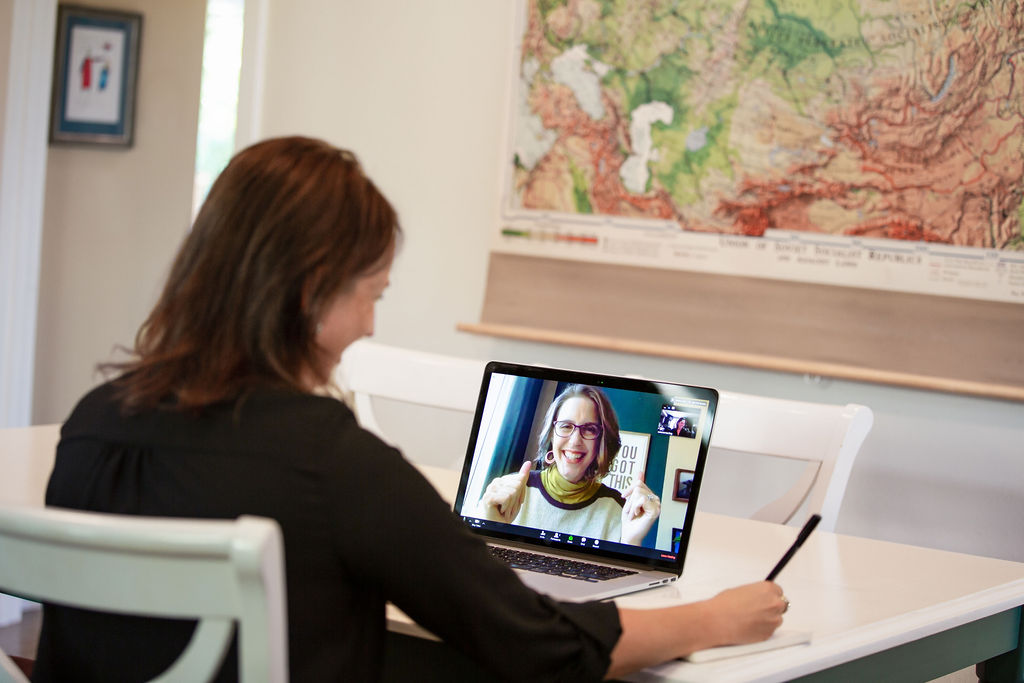
3) Creating sustainable business processes
Savvy business owners start thinking about their business systems on day one. But most new designers don’t know how essential it is to create sustainable business processes early-on, before it gets messy. But after they’ve been in the biz a few years and have created a hot behind-the-scenes mess, they come to me as burnt-out, haggard design veterans at their wit’s end.
That’s when it’s time for a good spring cleaning! We assess what they’re doing, where their energy and time are going, and what they’ve been trying to build. And then, we map out a systems overhaul that’ll set them up for decades of success.
Most new designers don’t know how essential it is to create sustainable business processes.
When I work with new design-preneurs, I try to help them get ahead of that so they have happy clients, sustainable habits, and profitable projects from the start!
How do you help design companies balance creativity with profitability?
The key to balancing creativity and profitability is to make sure we’re designing the right thing from the very start of the design process.
That means that everything, from our intake forms to what we ask during the discovery call and initial consultation, should be working hard to ensure we’re crystal clear on the client’s design goals, challenges, hopes, fears and vision. Ideally, what they want will be clear enough that you’re never designing while guessing. And I hate designing while guessing.
Designing while guessing means you waste valuable creative time chasing a rabbit down the wrong hole. Once you discover your error (too often after presenting the client with something they don’t like), you not only have to restart the design process and either charge the client more (not good) or eat into your profits (also not good). You also have to scramble to reestablish that hard-earned client trust.
The feeling of failure that comes with “getting it wrong” destroys our creativity because whatever confidence we once felt evaporates every time we have to start over.
So I help interior design entrepreneurs identify and practice the questions they need to ask so they get the essential information they need to design effectively for their clients — before they start designing!
Can you tell us about a particularly memorable or unique project you have worked on as a coach/consultant?
It’s hard to pick! But let’s chat about my client who was getting lots of great inquiries and going on lots of initial consults but having a heck of a time getting people to say “yes” to working with her.
It turned out her Design Agreement was a big turn-off for her clients. Instead of welcoming her clients in, it was actually creating an obstacle to saying yes.
Through our work, she reshaped the Agreement and signed her very next client! I love it when we can change something so fundamental, because that kind of change will pay off with every single client she ever works with. That is some serious coaching ROI!
What are the most important marketing channels for design businesses, and which ones are overrated?
The most important marketing channel for an interior design business is the one you’ll nurture consistently. You can succeed on Instagram, Facebook, Pinterest, LinkedIn, or Houzz. You can leverage Yelp like we did, or spend big bucks on luxury magazine, TV, or radio ads. You can build a YouTube following, or a passionate podcast fanbase. You can even nurture an in-person referral pipeline through networking groups like BNI or WBO.
Most interior design marketing fails because people quit. It’s a marathon, not a sprint.
My advice is to pick one platform, develop a non-generic marketing focus, and then stick to it for at least six months before you abandon it or add another platform.
Honestly, most interior design marketing fails because people post a couple of times, don’t see results, and quit. It’s a marathon, not a sprint, and you’ve simply got to keep putting one foot in front of the other.
Do your clients use 3D visualization for marketing? And if not, do you advise them to?
If you’ve got a bunch of stunning photos of your work then 3D visualization might not be as important for your marketing. But if you’re newer to the biz, it’s a remarkable tool that can help you sell large projects much earlier in your career. It helps your clients see your designs long before they’ve been built.
And 3D visualization isn’t just impressive, it’s also a great design and decision-guiding tool. With a few clicks, you can give your clients (and yourself!) a sense of how that crazy wallpaper will feel in the room, or understand how opening a wall will flood a room with light! Feeling confident long before demolition starts helps keep your clients from second-guessing their choices between the time you design and the date you finally install!

Five years ago I think you could still get away with designing only in 2D. But these days 3D rendering software is so readily available that if you’re not using it, you’re putting yourself at risk. The great news is that you don’t have to be a tech genius or millionaire to use these tools! Since not every project needs photorealistic renderings, you can try tools like Sketch Up or the Chief Architect programs — these are perfect for figuring out your design, and the 3D modeling is good enough to help most homeowners understand where the project is going.
3D visualization isn’t just impressive, it’s also a great design and decision-guiding tool.
Now, for high-end projects, and certainly, for big commercial or hospitality projects, you may want to level up to photorealistic 3D visualization. You’ll definitely want that if you’re using those renderings in your marketing! You can learn how to use specialized software to get there on your own. But if that’s not the smartest place to put your time, you can find thousands of companies eager to help in the global online community. So there’s really no excuse for not using CGI anymore, and your clients will expect it.
3D renderings by ArchiCGI studio
Can you tell us about a time when you had to help a design business pivot or change direction?
Most of my clients come to me with a dream of the kind of design company they want to build, but with fears and assumptions that make them question if it’s possible. A lot of times it comes down to them not believing they can charge enough to make a living (because they don’t see the value of their work).
It’s more often my job to offer encouragement to stay the course than it is to help designers change direction or pivot.
In fact, I recently had a client who had just finished launching her website and was just beginning to market herself when she started talking about launching a nonprofit instead of a for-profit company. I think nonprofits are great. But I wondered if this was coming from a desire to give back, or a fear of charging paying clients.
We dug into where the impulse was coming from and, sure enough, she was just afraid no one would pay her for her work. We spent the rest of the session focusing not on the cost of her services, but on the value of her services. By the end of the session, she was excited and eager to keep chasing her dream and become the well-paid professional she knows she can be!
So I’d say it’s more often my job to offer encouragement to stay the course than it is to help designers change direction or pivot. During our work together, they may make big, bold changes to their website copy, initial consult process, presentation skills, and other biz systems. But it’s always with the goal of making their dream possible.
What are the latest trends and technologies that you have incorporated into your coaching and consulting practice?
A few of the tools I use in my coaching practice are also great tools for interior designers to use!
One will be no surprise: my Acuity Scheduling system. It’s important to find ways to minimize admin time in our businesses, not only because admin time is not revenue-generating, but also because we want to make it as easy as possible for our clients to work with us. If designers use a self-scheduling option like Acuity to let clients book a discovery call, that saves at least one administrative step in the onboarding process, and eliminates one barrier between you and your client.
The other might be less well-known: Loom. Loom is a video messaging tool that lets you send video messages that record both your face and your screen, and then easily and instantly share that video with a client. As a coach, I use it to talk through copy and layout ideas when I’m helping improve a client’s website. But as a designer, I love it for explaining tricky design solutions. It’s much easier to share my screen and walk a client through a few changes in my design program than to try and describe those changes in an email! Video helps keep everyone on the same page and avoid miscommunication.
Here’s an example of a Loom video I threw together to clue a contractor in about what prospective clients wanted to have him estimate. It’s a great time-saver!
What is the key to developing and maintaining positive relationships with clients and stakeholders?
The key to developing and maintaining positive relationships with clients (and contractors) is age-old wisdom: do what you say you will. Under-promise and over-deliver. And when things go sideways, focus on finding a solution, not placing blame.
It’s just not enough to have design talent. You’ve got to learn how to communicate effectively. Be brave enough to have the hard conversations, and never text when emotions are on the line. Don’t waste your client’s time with useless meetings. Show up prepared, guide your clients through a professional process, and help them achieve their goals in the easiest, most low-stress way you can.
You’ve got to learn how to communicate effectively. Be brave enough to have the hard conversations, and never text when emotions are on the line.
All of that comes from figuring out what you do best and who you do it for, developing a clear and confident design process, and inviting the right clients to work with you in the first place (which means saying ‘no’ to the wrong-fit clients!).
How do you measure the success of your coaching and consulting work with a particular client?
How we measure success, and what we measure, depends on the goals of the client. If their primary struggle was getting clients, then we measure success based on booking initial consults. If their primary struggle was converting potential clients into paying clients, then we measure conversion rates. And if it was keeping momentum in projects and wrapping them up successfully, then we measure the time projects are taking and try to tighten that up by improving the designer’s process, presentation skills, and ability to help their clients make quick, confident decisions.
Nearly every business goal can be tied to a metric. The key is to find the connections between what we’re doing and what we’re getting, determine how that’s affecting the bottom line, and then start improving those numbers!
You chose the name Seriously Happy for your company. How do you incorporate mindfulness and emotional intelligence into your coaching practice?
Being an interior designer is remarkably challenging. We help clients navigate one of the hardest, most expensive projects they’ll ever take on, projects that often last months if not years, while still working their full-time jobs and taking care of pets, kids, and aging parents. Plus, if our project involves two people, that couple often has history and emotional baggage that has a way of making the job much harder than it should be.
Because of all that, the more emotionally intelligent we are as designers, the more successful we’ll be. We have to learn how to not take things personally, focusing on the outcome we want rather than the emotions we may feel. We have to learn how to help our clients calm down when things go sideways, and help them make decisions even when they might not be perfectly happy with the options. (for example, when their budget doesn’t fit their vision, or when a mistake is made, but fixing it the way they want will cause a big delay).
No design or remodeling project will ever go perfectly. The great news is that your value really shows up when things don’t go as planned. That’s when you can be a great example of what it looks like to be a solution-focused partner, skipping right over the blame-game, and getting the project back on track. Everyone, from the client to the contractor, will be impressed!
Your value really shows up when things don’t go as planned.
So I help my clients prepare for the inevitable road bumps. And when they show up, I help them turn those obstacles into opportunities to shine!
What key piece of advice would you give to a new design business just starting out?
Track your time. All of it.
When I start working with a new coaching client, one of the first questions I ask is whether they are tracking their time. It doesn’t seem to matter if they just started their business or they’ve been at it for 15 years — most sheepishly admit that they don’t track their time. Or if they do, it’s just their design hours, and even those are round numbers.
Tracking your time is one of the easiest ways to hack efficiency.
Not tracking your time means you don’t really know where your time is going, and you don’t have a realistic sense of what you really make per hour. Worse, you miss out on valuable data that can help you make important decisions, like when to hire and what to outsource so you’re free to do the things that generate the most revenue for your company.
But if you do track your time, you not only develop essential entrepreneurial discipline — you can also measure how profitable your design process is, figure out who to hire and when, and set standards and achievable expectations for your team members.
Most importantly, tracking your time is one of the easiest ways to hack efficiency. When you know you’re “on the clock” tracking your work, it’s much easier to ignore those email and phone notifications. That focus helps you get more done in less time!
So, find a time tracking app that will let you set categories, like “marketing,” “design,” “bookkeeping,” “janitorial,” etc, and that makes it easy to pull useful reports so you can see where your time is going. Then start making informed decisions like a Boss. It’ll set a great foundation for everything else in your business!
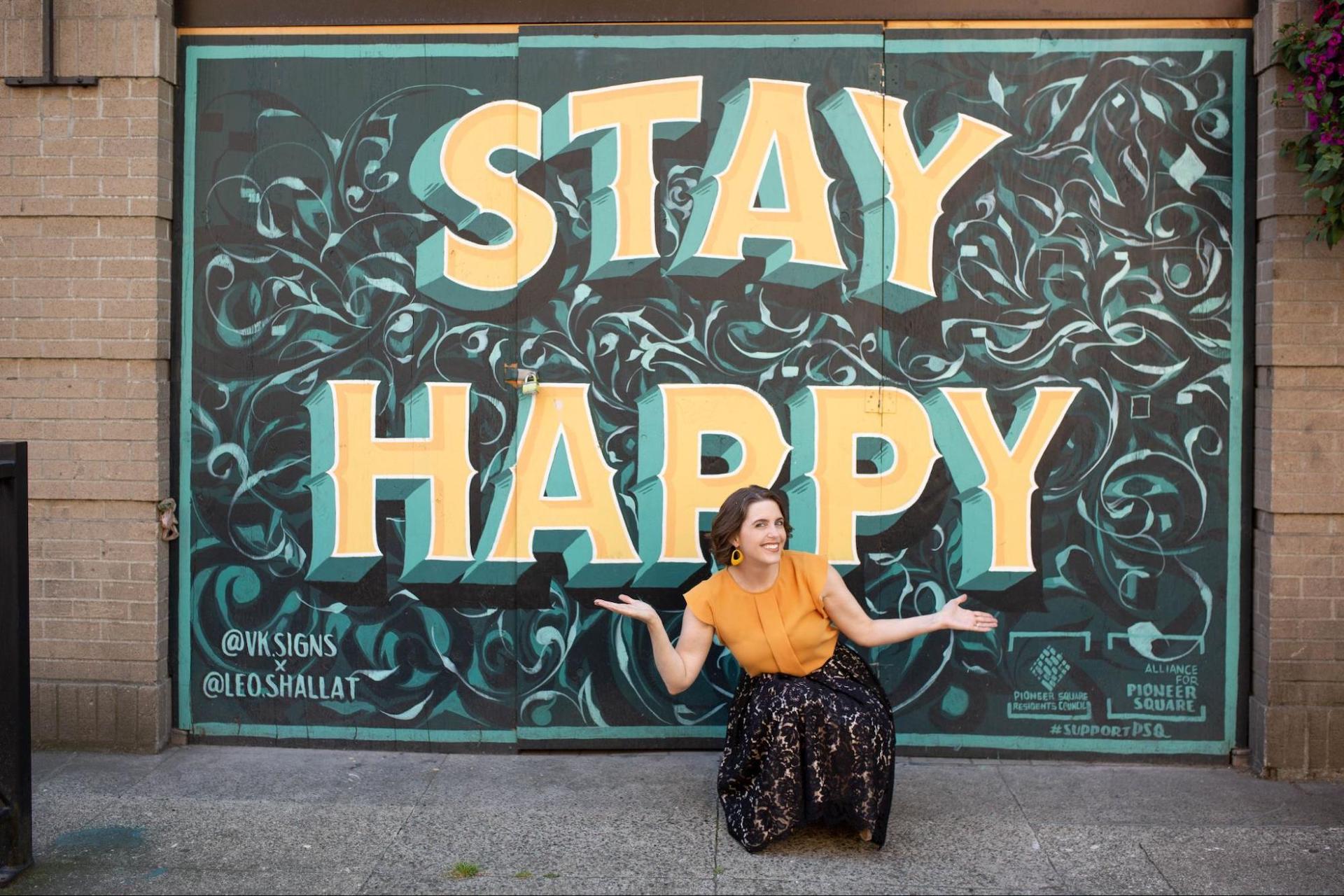
Our team thanks Rebecca West for sharing her remarkable journey and expertise with us in this interview. We are confident that our readers will find her insights and experiences truly inspiring. And we wholeheartedly wish Rebecca and her team at Seriously Happy all the best in their continued endeavors.
Want to learn how much your project costs? See how we evaluate 3D rendering projects
Looking for professional 3D rendering services to visualize your interior designs? Contact us at ArchiCGI and get a free consultation to learn more about what we can do for you!

Ana Wayne
Content Writer, Copywriter
Ana is a content writer for ArchiCGI. She has a passion for design and architecture - and for talking about it. Outside of work, she is a fan of sci-fi movies and a street food connoisseur.



